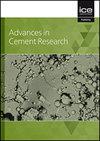利用低反应性粉煤灰制备地质聚合物材料
IF 1.3
4区 工程技术
Q3 CONSTRUCTION & BUILDING TECHNOLOGY
引用次数: 0
摘要
低反应性飞灰(LRFA)是从低温燃烧炉中获得的,是一种低火山灰活性灰,是危险废物,不适合工程应用。本工作的目的是研究通过使用LRFA与煅烧高岭土混合作为前体来制备水泥替代材料(即地质聚合物)的混合程序。氢氧化钠和硅酸钠的混合物用作碱性溶液。结果表明,为了获得足够的强度用于工程应用,需要顺序混合(SM)程序。采用传统的混合方法,地质聚合物具有高孔隙率和低强度。因为在硬化过程中,碱性溶液和LRFA中的杂质之间的反应会产生气泡。通过使用SM方法,在地质聚合物硬化之前释放产生的气泡。结果,孔隙率降低,并且强度显著增加。SM法制备的地质聚合物的7天强度高于硅酸盐水泥的最低要求。此外,SM程序减少了LRFA地质聚合物的凝固时间,这对于快速修复应用是一个优势。本文章由计算机程序翻译,如有差异,请以英文原文为准。
Utilization of Low Reactivity Fly Ash for Fabricating Geopolymer Materials
Low reactivity fly ash (LRFA) is obtained from a low temperature combustion furnace, is a low-pozzolanic activity ash, is a hazardous waste, and is undesirable for engineering applications. The aim of this work is to investigate the mixing procedure for fabricating a cement replacement material, i.e., geopolymer by using LRFA blended with the calcined kaolinite clay as a precursor. A mixture of sodium hydroxide and sodium silicate is used as an alkaline solution. The results show that to obtain sufficient strength for engineering applications, the sequence mixing (SM) procedure is required. Using the conventional mixing method, geopolymer has high porosity and low strength. Because the gas bubbles are generated from the reaction between alkaline solution and the impurity in LRFA during the hardening process. By using the SM method, the generated gas bubbles are released before the geopolymer is hardened. As a result, the porosity is reduced, and the strength is significantly increased. The 7-day strength of geopolymer fabricated by the SM method is higher than the minimum requirement of Portland cement. In addition, the SM procedure reduces the setting time of LRFA-geopolymer, which is an advantage for rapid repair applications.
求助全文
通过发布文献求助,成功后即可免费获取论文全文。
去求助
来源期刊

Advances in Cement Research
工程技术-材料科学:综合
CiteScore
3.70
自引率
5.00%
发文量
56
审稿时长
3.2 months
期刊介绍:
Advances in Cement Research highlights the scientific ideas and innovations within the cutting-edge cement manufacture industry. It is a global journal with a scope encompassing cement manufacture and materials, properties and durability of cementitious materials and systems, hydration, interaction of cement with other materials, analysis and testing, special cements and applications.
 求助内容:
求助内容: 应助结果提醒方式:
应助结果提醒方式:


